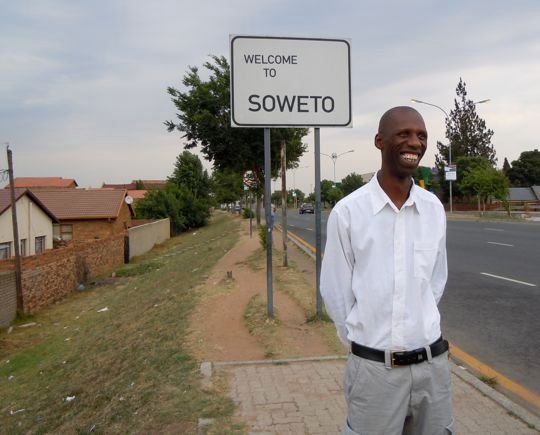Our big, white tour bus took us to the township of Soweto this morning. A tall man with a shaved head and large smile stepped aboard as we left the Protea Hotel Wanderers and introduced himself in his native tongue, in which Mpumelelo means success. He also goes by Kenny Takalo, and he succeeded in explaining why the history of this 80-square-mile township within Johannesburg has mattered so much in the story of South Africa. Soweto is home to 2.5 million people, including Kenny, who is a native Sowetan.
Although the bus’s sound system brought Kenny’s voice to us with a muffled echo, I was riveted by his commentary. He described the transition from apartheid to a free society with unblinking candor, devoid of judgment or rancor. For example, he said the history of black and white schools explains why the former are having more difficulty attracting students of all races than the latter.
“Blacks were seen as a servant community in the country,” he said, “and the education had to fit such. It was actually designed. On the other hand, there was this white education which was thought to be the best, because it was designed for what was considered the superior race during the time. So the kind of education, the training the teachers have received, the facilities were the best, hence it is easy to attract people.”
Kenny offered this explanation for his belief that changes to the education system will take a generation:
“I would say in the first generation in a free country, it is not the actual freedom, but the freedom to choose freedom. So, if people in the process are having the freedom to empower themselves to get an education and to fight for their rights without fearing incarceration or anything, the second generation will be the ones who are actually building up from what the generation before them left. And maybe two generations of that freedom, we will actually see freedom.”
Our bus navigated like a precise whale through the streets of Soweto, where Kenny pointed out the current home of Winnie Mandela, the controversial former wife of Nelson Mandela. The wheelman also slowed on Vilakazi Street as we passed the one-time residence of Archbishop Desmond Tutu. The bus stopped four times to let us off, beginning at the “Welcome to Soweto” sign, followed by Freedom Square and its 10 pillars of the 1955 Freedom Charter, again at the former home of Nelson Mandela and Winnie, and, finally, at a museum commemorating the Soweto uprising on June 16, 1976. The museum is named after Hector Pieterson, a 12-year-old boy who was killed by police that day. The boy became an icon because of an unforgettable photoraph showing a man carrying the small body as Hector’s sister runs along beside them, in tears.
As we returned to the hotel, Kenny recalled the release of Nelson Mandela from prison on February 11, 1990. “Nothing was bigger than the freedom of Mandela in this country at that time,” he said. Television coverage began at 6:30 that morning, and finally at just after 2:30 in the afternoon, Mandela came out, a man who was not supposed to exist, the mention of whose name was a crime, but whose image from the years of his active resistance, in his 40s, had came to represent the dream of freedom. “I could not see Mandela,” Kenny said of the TV coverage. “What I could see was an old man walking with Winnie, but where was my Mandela?” At first it seemed odd to Kenny that there was no dancing and celebrating among those with whom he watched the event on TV. Then he realized this was something larger, beyond any celebration: “It was the very first second in their entire lives that they felt free, because all their lives, every second was lived knowing freedom only by name.”
Our bus was not the only whale visiting Soweto today, but it still felt odd to look out through tinted windows on bleak expanses, in some cases, of fragile, makeshift structures masquerading as homes. I might have expected angry gestures from people alongside the road as we passed or stopped, close enough for a few moments of looking into the eyes of a stranger. Instead, those looking at us often simply smiled, and waved.

